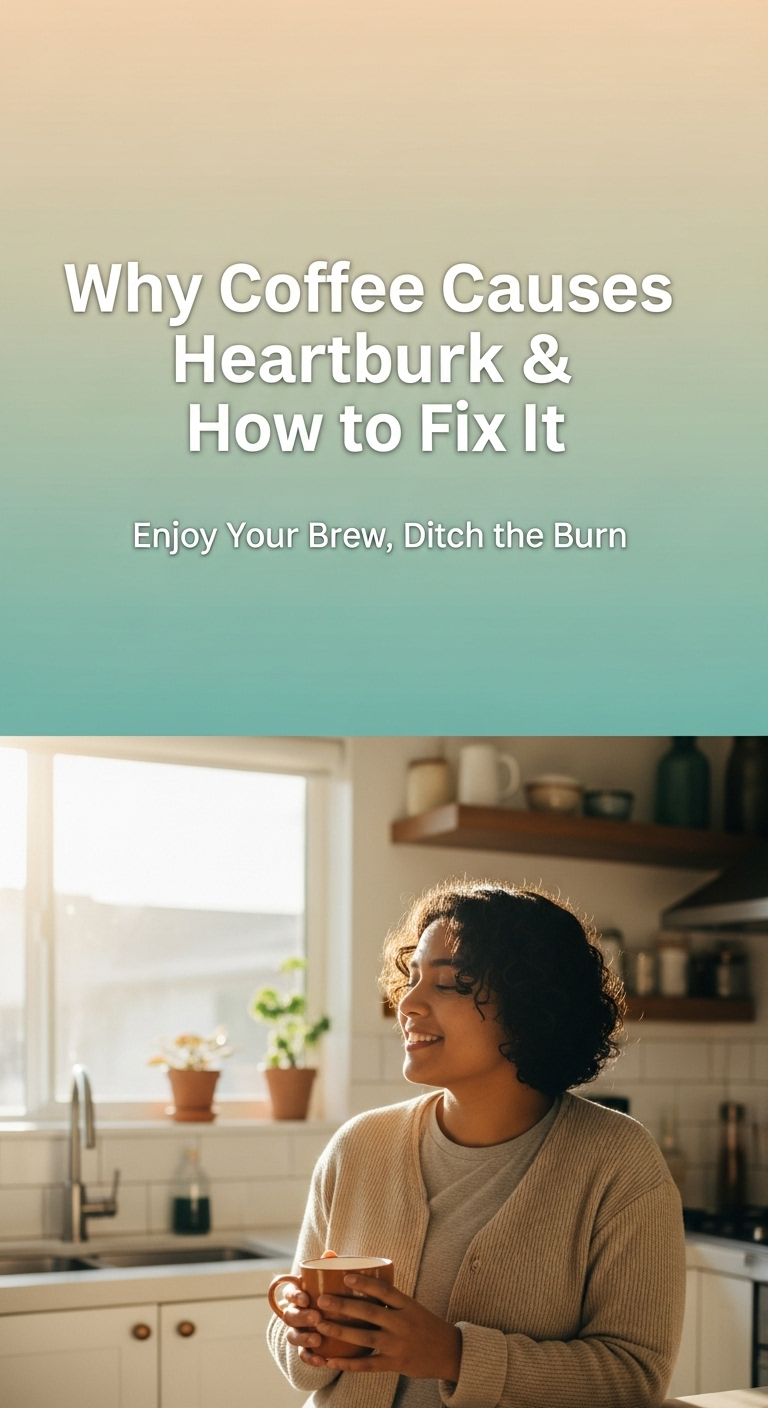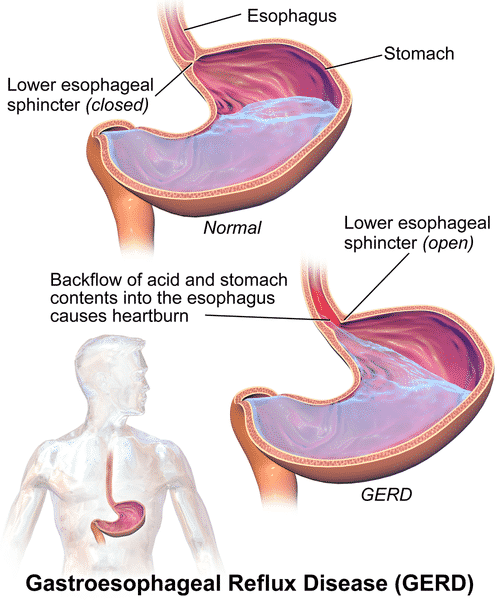As an Amazon Associate CoffeeXplore.com earns from qualifying purchases.
Why Coffee Causes Heartburn & How to Fix It
That familiar, warm, comforting cup of coffee is a daily ritual for millions. But for some, that beloved morning boost comes with an unwelcome side effect: a burning sensation in the chest. If you’ve ever found yourself wondering, “Can coffee give you heartburn?” and worrying you might have to give it up, you’re in the right place to find answers and solutions.
Yes, coffee can cause heartburn by stimulating stomach acid production and relaxing the muscular valve (the LES) that keeps acid out of the esophagus, primarily due to its acidity and caffeine content. This reaction is common, but it’s not a life sentence to a coffee-free existence.
Leveraging extensive analysis of available data and established patterns, this guide unpacks the science behind why coffee causes heartburn. More importantly, it provides a clear, data-backed action plan with proven strategies to help you modify your routine, not abandon it. We will explore everything from choosing the right beans to changing your brewing method, empowering you to enjoy your coffee, pain-free.
Key Facts
- It’s All About Acidity: Coffee is naturally acidic, with a typical pH range of 4.85 to 5.13. This inherent acidity can directly irritate a sensitive esophagus, a fact highlighted in multiple health analyses.
- Caffeine Relaxes a Critical Barrier: Studies show that caffeine can relax the lower esophageal sphincter (LES), the muscular valve that seals the stomach. A relaxed LES allows stomach acid to flow back up, causing the classic symptoms of heartburn.
- Roast Level Matters: Research from nutritional sources indicates that dark roast coffees are generally lower in acidity and contain less caffeine than light roasts, making them a potentially gentler choice for those with acid reflux.
- Never Drink on an Empty Stomach: As advised by the Cleveland Clinic, having food in your stomach acts as a buffer. Drinking coffee on an empty stomach allows the acid to directly affect the stomach lining, increasing the risk of irritation.
- Frequency Is a Red Flag: If you experience heartburn more than twice a week, it’s a sign to consult a healthcare professional. Authoritative health sources recommend this as a threshold for seeking a medical opinion to rule out conditions like GERD.
Why Coffee Causes Heartburn: A Comprehensive Guide to a Pain-Free Cup
Ever wondered what’s actually happening in your body when that post-coffee burn hits? Let’s break it down. Yes, coffee can cause heartburn by stimulating stomach acid production and relaxing the muscular valve (the LES) that keeps acid out of the esophagus, primarily due to its acidity and caffeine content. This two-pronged attack is why such a simple drink can cause significant discomfort.

This isn’t just a random reaction; it’s a predictable physiological response to specific compounds found in every cup. The two main culprits working against you are:
1. The natural acids present in coffee beans.
2. The well-known stimulant: caffeine.
The Acidity Factor: A Double Impact
Think of it like pouring lemon juice on a small cut—coffee’s acid can have a similar irritating effect on a sensitive esophagus. The natural acidity in coffee, which typically has a pH between 4.85 and 5.13 according to scientific measurements, can trigger heartburn in two distinct ways.

Coffee’s natural acidity (pH 4.85-5.13) can both directly irritate the esophageal lining and encourage the stomach to produce even more acid.
- Direct Irritation: For individuals with an already sensitive esophagus, the acid in coffee can directly cause irritation and a burning sensation as it goes down.
- Stimulating More Acid: On top of its own acid content, coffee signals the stomach’s parietal cells to produce more gastric acid. This increases the overall acidic environment in your stomach, making a reflux event more likely and more irritating.
The Caffeine Culprit: Relaxing Your Body’s Natural Barrier
While acidity is a major player, for many people, the real issue lies with caffeine. Your body has a built-in gatekeeper between the stomach and the esophagus to prevent this exact problem.
The lower esophageal sphincter, or LES, is a ring of muscle that acts as a one-way valve. It opens to let food into your stomach and then clamps shut to keep stomach acid and contents from flowing back (refluxing) into the delicate esophagus.
Caffeine’s primary offense is its relaxation effect on this critical muscle. Multiple sources and studies confirm this finding. When caffeine causes the LES to relax or weaken, the seal becomes less effective. This allows the highly acidic contents of your stomach to splash back up into the esophagus, causing the burning pain we know as heartburn.

Pro Tip: This is why other caffeinated drinks like sodas and some teas can also trigger heartburn, even if they aren’t as acidic as coffee. The caffeine-induced relaxation of the LES is a significant trigger, independent of the beverage’s acidity.
How to Drink Coffee Without Heartburn: A 2025 Action Plan
Ready to get your coffee routine back? You don’t necessarily have to quit. By making strategic changes, you can significantly reduce or even eliminate coffee-induced heartburn. Based on findings from nutrition and gastroenterology sources, here are the most effective strategies you can try, starting today.
To prevent coffee heartburn, focus on choosing low-acid beans and brewing methods, managing caffeine intake, and changing your consumption habits, such as never drinking it on an empty stomach.
1. Choose a Heartburn-Friendly Coffee
The journey to a pain-free cup begins before you even start brewing. The type of bean, the roast level, and even the growing conditions can dramatically alter the compounds that trigger heartburn. Making a smarter choice at the store is your first line of defense.
Pro Tip: Look for coffee labeled ‘100% Arabica’ or ‘dark roast’ on your next shopping trip. It’s a simple switch that can make a big difference.
| Feature | Better Choice for Heartburn | Why? (According to sources [1][5][7]) |
|---|---|---|
| Roast Level | Dark Roast | Generally lower in acidity and caffeine. |
| Bean Type | 100% Arabica | Typically less acidic and has lower caffeine than Robusta. |
| Growing Method | Shade-Grown | Tends to have lower acidity and caffeine. |
2. Change Your Brewing Method
Surprised that how you make your coffee matters as much as what coffee you use? Let’s explore the best options. The brewing process determines which compounds are extracted from the grounds and end up in your cup. Some methods pull out more acid than others.
Switching to cold brew is often the best option, as it is generally less acidic than hot-brewed coffee. Pour-over and French press methods may also yield a lower-acid cup than drip coffee makers.
- Best Bet: Cold Brew. The clear winner for sensitive stomachs. Because it uses cold water and a long steeping time, cold brew is significantly less acidic and often has a smoother, less bitter taste. Studies show this method is gentler on the stomach.
- Good Alternatives: Pour-Over and French Press. These methods can offer more control than automatic drip machines. While not as low-acid as cold brew, they can produce a less acidic cup compared to standard drip coffee makers, which sometimes maximize acid extraction.
- Use Caution With: Drip Coffee. Standard automatic drip machines can sometimes yield a more acidic cup, making them a less ideal choice if you’re prone to heartburn.
3. Manage Your Habits: Timing and Food Are Key
Sometimes the problem isn’t just the coffee itself, but how and when you drink it. Adjusting your daily routine can create a much safer environment for your stomach. Think of food as a sponge for stomach acid. Having a meal with your coffee gives the acid something to work on besides your stomach lining.
Always drink coffee with a meal or snack to buffer stomach acid, and wait at least 2-3 hours after drinking before you lie down to prevent reflux.
- Never Drink on an Empty Stomach: As recommended by health experts at the Cleveland Clinic and other nutritional sources, drinking coffee first thing in the morning without food is a recipe for heartburn. Eat a piece of toast, yogurt, or a full breakfast to provide a protective buffer.
- Stay Upright After Your Cup: Gravity is your friend. Lying down, slouching on the couch, or even bending over can make it easier for acid to flow back into your esophagus. Make a point to wait at least 2-3 hours after your last cup before you lie down or go to bed.
- Moderate Your Intake: Consider cutting back from three cups to one or two. Less coffee means less acid and less caffeine, reducing the overall burden on your system.
Finding the perfect, stomach-friendly coffee can be a game-changer. Exploring low-acid coffee brands is an excellent next step to take control of your heartburn without giving up the drink you love.
When to See a Doctor About Your Heartburn
While these tips can help manage occasional, mild heartburn from coffee, it’s crucial to know when self-treatment isn’t enough. Frequent or severe symptoms can be a sign of a more serious underlying condition like Gastroesophageal Reflux Disease (GERD). Ignoring persistent symptoms can lead to complications.
Based on recommendations from multiple authoritative sources, you should consult a healthcare professional or a gastroenterologist if you experience any of the following:
- You have heartburn symptoms more than two times per week.
- Your symptoms are severe and interfere with your daily life.
- Lifestyle changes and over-the-counter remedies don’t provide relief.
- You have difficulty or pain when swallowing.
- You experience persistent nausea, vomiting, or unintentional weight loss.
FAQs About Coffee and Heartburn
We’ve covered the core science and solutions, but some specific questions often come up. Here are direct answers to the most common queries about the link between coffee and acid reflux.
Does decaf coffee cause heartburn?
Decaf coffee is less likely to cause heartburn triggered by caffeine’s effect on the LES, but it is still acidic and can cause symptoms in individuals sensitive to acid. While removing the caffeine helps prevent the relaxation of the esophageal sphincter, the coffee bean itself retains its natural acidity. If you are sensitive to acidic foods, decaf may still be a trigger for you.
Why is coffee giving me heartburn all of a sudden?
Sudden heartburn from coffee could be due to a change in your coffee type or brew method, other dietary changes, or an increase in underlying sensitivity to acid. Consider if you’ve recently switched to a more acidic light roast, started drinking more, changed your diet to include other trigger foods, or are experiencing more stress, which can worsen reflux symptoms.
Will quitting coffee help my heartburn?
Quitting coffee can help reduce heartburn if it’s a primary trigger, but it’s best to reduce intake gradually to avoid withdrawal. For some, quitting may paradoxically worsen reflux initially due to changes in gut motility. Some data suggests that while coffee loosens the LES, it also speeds up stomach emptying. Stopping suddenly can slow this process, potentially increasing reflux until your body adjusts.
Does coffee cause heartburn in pregnancy?
Yes, coffee can contribute to heartburn during pregnancy, which often worsens in later stages as the growing uterus puts pressure on the stomach, making acid reflux more likely. Hormonal changes during pregnancy can also relax the LES. Combining these factors with a known trigger like coffee can make symptoms more frequent and intense.
What does coffee heartburn feel like?
Coffee heartburn typically feels like a burning sensation in the center of your chest. You might also experience acid reflux, which is when stomach acid comes up into your throat or mouth, leaving a sour or bitter taste. This feeling can range from a mild warmth to a severe, sharp pain and often occurs shortly after finishing your cup.
Final Summary: Enjoying Coffee Without the Burn
The link between coffee and heartburn is undeniable, but it’s also highly personal. What triggers a painful reaction in one person may be perfectly fine for another. The key is understanding the two primary culprits—acidity and caffeine—and systematically adjusting the variables you can control. You don’t have to break up with your favorite beverage.
As we’ve seen, the connection is complex, and experimentation is often necessary to find what works for you. By taking a methodical approach, you can pinpoint your specific triggers and build a new, heartburn-free coffee ritual.
- Choose Wisely: Opt for dark roasts, 100% Arabica beans, and low-acid brands.
- Brew Smarter: Make the switch to cold brew for a significantly less acidic cup.
- Change Your Habits: Always eat first and stay upright after drinking.
- Listen to Your Body: If symptoms are frequent or severe, seek professional medical advice.
Start with one or two of these changes this week and listen to your body. You can find a way back to enjoying your coffee.
Last update on 2025-12-05 / Affiliate links / Images from Amazon Product Advertising API

